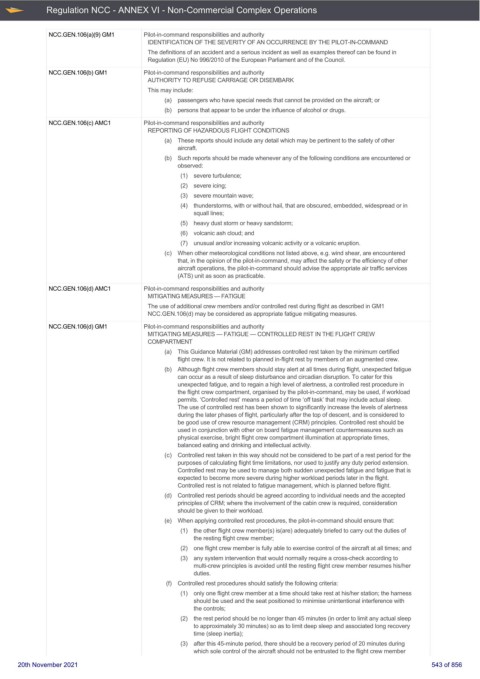Page 543 - UK Air Operations Regulations (Consolidated) 201121
P. 543
~
~ Regulation NCC - ANNEX VI - Non-Commercial Complex Operations Centrik
NCC.GEN.106(a)(9) GM1 Pilot-in-command responsibilities and authority
IDENTIFICATION OF THE SEVERITY OF AN OCCURRENCE BY THE PILOT-IN-COMMAND
The definitions of an accident and a serious incident as well as examples thereof can be found in
Regulation (EU) No 996/2010 of the European Parliament and of the Council.
NCC.GEN.106(b) GM1 Pilot-in-command responsibilities and authority
AUTHORITY TO REFUSE CARRIAGE OR DISEMBARK
This may include:
(a) passengers who have special needs that cannot be provided on the aircraft; or
(b) persons that appear to be under the influence of alcohol or drugs.
NCC.GEN.106(c) AMC1 Pilot-in-command responsibilities and authority
REPORTING OF HAZARDOUS FLIGHT CONDITIONS
(a) These reports should include any detail which may be pertinent to the safety of other
aircraft.
(b) Such reports should be made whenever any of the following conditions are encountered or
observed:
(1) severe turbulence;
(2) severe icing;
(3) severe mountain wave;
(4) thunderstorms, with or without hail, that are obscured, embedded, widespread or in
squall lines;
(5) heavy dust storm or heavy sandstorm;
(6) volcanic ash cloud; and
(7) unusual and/or increasing volcanic activity or a volcanic eruption.
(c) When other meteorological conditions not listed above, e.g. wind shear, are encountered
that, in the opinion of the pilot-in-command, may affect the safety or the efficiency of other
aircraft operations, the pilot-in-command should advise the appropriate air traffic services
(ATS) unit as soon as practicable.
NCC.GEN.106(d) AMC1 Pilot-in-command responsibilities and authority
MITIGATING MEASURES — FATIGUE
The use of additional crew members and/or controlled rest during flight as described in GM1
NCC.GEN.106(d) may be considered as appropriate fatigue mitigating measures.
NCC.GEN.106(d) GM1 Pilot-in-command responsibilities and authority
MITIGATING MEASURES — FATIGUE — CONTROLLED REST IN THE FLIGHT CREW
COMPARTMENT
(a) This Guidance Material (GM) addresses controlled rest taken by the minimum certified
flight crew. It is not related to planned in-flight rest by members of an augmented crew.
(b) Although flight crew members should stay alert at all times during flight, unexpected fatigue
can occur as a result of sleep disturbance and circadian disruption. To cater for this
unexpected fatigue, and to regain a high level of alertness, a controlled rest procedure in
the flight crew compartment, organised by the pilot-in-command, may be used, if workload
permits. ‘Controlled rest’ means a period of time ‘off task’ that may include actual sleep.
The use of controlled rest has been shown to significantly increase the levels of alertness
during the later phases of flight, particularly after the top of descent, and is considered to
be good use of crew resource management (CRM) principles. Controlled rest should be
used in conjunction with other on board fatigue management countermeasures such as
physical exercise, bright flight crew compartment illumination at appropriate times,
balanced eating and drinking and intellectual activity.
(c) Controlled rest taken in this way should not be considered to be part of a rest period for the
purposes of calculating flight time limitations, nor used to justify any duty period extension.
Controlled rest may be used to manage both sudden unexpected fatigue and fatigue that is
expected to become more severe during higher workload periods later in the flight.
Controlled rest is not related to fatigue management, which is planned before flight.
(d) Controlled rest periods should be agreed according to individual needs and the accepted
principles of CRM; where the involvement of the cabin crew is required, consideration
should be given to their workload.
(e) When applying controlled rest procedures, the pilot-in-command should ensure that:
(1) the other flight crew member(s) is(are) adequately briefed to carry out the duties of
the resting flight crew member;
(2) one flight crew member is fully able to exercise control of the aircraft at all times; and
(3) any system intervention that would normally require a cross-check according to
multi-crew principles is avoided until the resting flight crew member resumes his/her
duties.
(f) Controlled rest procedures should satisfy the following criteria:
(1) only one flight crew member at a time should take rest at his/her station; the harness
should be used and the seat positioned to minimise unintentional interference with
the controls;
(2) the rest period should be no longer than 45 minutes (in order to limit any actual sleep
to approximately 30 minutes) so as to limit deep sleep and associated long recovery
time (sleep inertia);
(3) after this 45-minute period, there should be a recovery period of 20 minutes during
which sole control of the aircraft should not be entrusted to the flight crew member
20th November 2021 543 of 856

